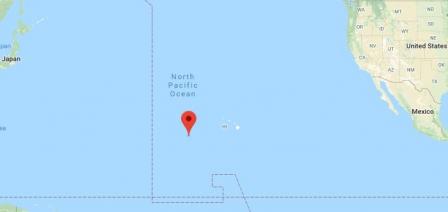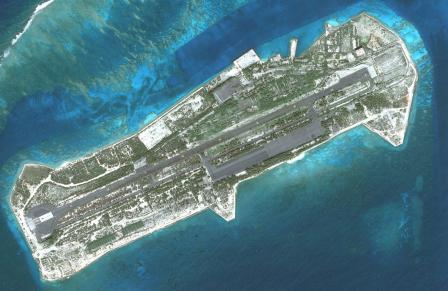A Resource Conservation and Recovery Act Permit Renewal
 Click to enlarge
Click to enlarge Click to enlargePursuant to the Resource Conservation and Recovery Act (RCRA), EPA is responsible for permitting facilities that manage RCRA-regulated hazardous wastes on United States Minor Outlying Islands, including Johnston Atoll which is under Air Force ownership and control. Johnston Atoll is currently uninhabited except for visits by U.S. Fish and Wildlife Service employees that are authorized by the Air Force. A RCRA permit, modified in 2004, was issued to the Air Force to conduct Corrective Action responsibilities on Johnston Atoll. The Air Force submitted an application to EPA to renew the permit in 2011 and submitted an updated application in September 2018.
Click to enlargePursuant to the Resource Conservation and Recovery Act (RCRA), EPA is responsible for permitting facilities that manage RCRA-regulated hazardous wastes on United States Minor Outlying Islands, including Johnston Atoll which is under Air Force ownership and control. Johnston Atoll is currently uninhabited except for visits by U.S. Fish and Wildlife Service employees that are authorized by the Air Force. A RCRA permit, modified in 2004, was issued to the Air Force to conduct Corrective Action responsibilities on Johnston Atoll. The Air Force submitted an application to EPA to renew the permit in 2011 and submitted an updated application in September 2018.
A public comment period on the proposed draft permit was held from October 31, 2018 to December 19, 2018. There were no comments on the proposed draft permit. The permit was finalized and went into effect on December 21, 2018.
Johnston Atoll’s Environment
Johnston Atoll is located in the Pacific Ocean about 717 nautical miles west-southwest of Hawaii. Johnston Island is the largest of four islands in the atoll complex. The other three islands are Sand Island, a natural islet, and North (Akau) and East (Hikina) Islands, which are manmade. Johnston Atoll is an unincorporated territory of the United States and is one of the oldest and most remote atolls in the world. Access to the atoll is via ocean vessel. As the only shallow water and dry land area in 450,000 square miles of ocean, Johnston Atoll is an oasis for reef and bird life. This includes coral and coralline algae, about 300 species of reef fish, threatened green sea turtles, and seabirds such as the great frigatebird, red-footed booby, redtailed tropicbird, sooty tern, and others. Johnston Atoll is also considered habitat for the endangered Hawaiian Monk Seal and a threatened coral species.
Johnston Atoll’s Military History and Hazardous Waste Legacy
Johnston Atoll’s military history began before World War II and continued until the island was decommissioned in 2004. At one time over 1,200 military and military contractor personnel lived at the Johnston Atoll. In the mid-1990s Johnston Island was the location of the Johnston Atoll Chemical Agent Disposal System (JACADS) which was used for destruction of chemical agents. The island has had two RCRA permits to store or treat hazardous waste, the JACADS facility permit and the Johnston Atoll permit. The hazardous waste management units associated with both permits have been closed and there are no hazardous waste management units operating at the Atoll at this time. There are Solid Waste Management Units and Areas of Concern left on the island that require maintenance and monitoring so the area is under Corrective Action. The facility and runway on Johnston Island were closed in June 2004 under the Johnston Atoll permit and Johnston Atoll is still under Air Force ownership and control.
Documents
-
RCRA Permit ID TT9 570 090 002 for Johnston Atoll Facility (PDF)(35 pp, 4 MB,
12/21/2018)
Resource Conservation and Recovery Act (RCRA) Permit issued to the US Air Force for their Johnston Atoll facility to perform corrective action activities
-
Statement of Basis: Notice of Approval of a RCRA Permit Application for Johnston Atoll (PDF)(1 pg, 87 K,
12/21/2018)
This document provides notice of the United States Environmental Protection Agency’s (EPA) final decision to issue the Resource Conservation and Recovery Act (RCRA) Permit to the United States Air Force, as facility owner and operator, for corrective action at Johnston Atoll.
-
Application for Johnston Atoll Facility RCRA Permit Renewal (PDF)(454 pp, 55 MB,
September 13, 2018)
The Air Force submitted a signed application on September 13, 2018 for a RCRA permit renewal to conduct Corrective Action at Johnston Atoll.
